Archive for the 'Fruit' Category

The peaches are ripening on the 6 year old O’Henry peach tree in our yard this week. The tree had about 200 peaches. That’s too many for me and my partner to eat before they rot. After giving some away, I still have a lot left. So I am going to turn a bunch of them into jarred peach preserves.
The peaches are tasty, but they are small in size, much smaller than last year’s crop. I think I should have thinned the fruit more. I waited too long to thin this year (July), and I didn’t remove enough of the pre-ripened fruit from the tree. Last year, this tree had far fewer peaches, but they were much larger. I think the peaches tasted better and were juicier last year.
Next year, I plan to prune the tree much more than I did this year. Peaches and nectarines fruit on one year old branches. If I remove more of the branches in the dormant season, the tree should have less fruit next year. I also plan to thin aggressively in May and June to reduce the crop to about 100 fruits.
O’Henry peaches are a good variety overall. They don’t rot easily or split, and I have never seen insects eating them. Although squirrels love them, so the tree needs to be netted.
My mom bought and planted this tree in our yard after she bought O’Henry peaches at a fruit stand and really enjoyed them. The tree has grown incredibly fast in the past two years, after I transplanted it from the front yard to a sunnier spot in the back yard. I waited too long in the dormant season to transplant it. The tree was just starting to bloom. It went into shock and nearly died. I fertilized and watered it excessively the spring and summer after that, and it came back in a big way. Now, it’s one of the best looking fruit trees in our yard, and it requires very little care. Besides watering and occasional fertilizing, the only special care I give it is dormant season spray for peach leaf curl and of course netting.
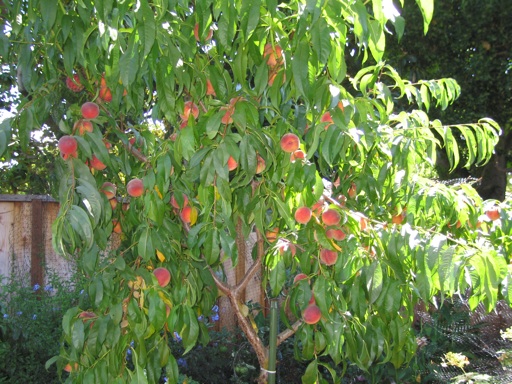
August 23 2008 | Peaches/Nectarines | Comments Off on O’Henry Peaches
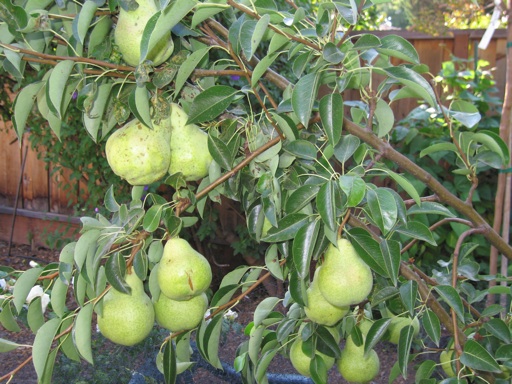
This is a picture of a small Bartlett pear tree in our yard. It is full of pears this year. I counted about 130. Mid-August is usually the time to harvest Bartlett pears in central California. Last year, this tree did not have a single pear.
The branches of the tree are so full of fruit, I have held them up using plastic chairs to keep the fruit off the ground. The branches of this tree are weak and spindly. A few of the branches broke off under the weight of the fruit. I have noticed that Bartlett pear trees often have an unattractive form. Overall, our tree is not a very good looking tree. But the quality of the pears it produces makes it well worth growing. The texture of the fruit is incredibly soft and buttery, and the flavor is sweet.
I am picking the pears before they are ripe and then letting them ripen indoors. Pears do not ripen properly on the tree. The fruit ripens from the inside out. If they are left on the tree until they seem ripe, the fruit may be rotten inside.
Color is one indication of when to harvest. Bartlett pears are usually ready to pick when they are a pale green color. Another technique involves lifting each fruit into a horizontal position. If the pear comes off the branch easily when lifted up, it is ready to harvest.
The fruit ripens in about 7-10 days when indoors at room temperature. Bartlett pears turn from green to yellow as they ripen. When the top of the pear near the stem (or the bottom of the pear) is soft to touch, it is ready to eat.
Bartlett pears are one of my favorite fruits. The pears I have eaten from our tree and from my parent’s Bartlett pear tree are the sweetest pears I have ever tasted.
Sometimes, when I have a large harvest of Bartlett pears, I store a portion of them in the refrigerator. Pears can be stored for weeks in refrigeration, which slows down the ripening process, and then brought back to room temperature to ripen fully. However, the Bartlett pears that I have eaten after refrigeration were not as sweet as the ones that were ripened at room temperature right after harvest.
The bottom picture is a small max’s red bartlett pear tree growing in a pot. It’s producing pears for the first time this year. The red bartlett pears I have eaten were even sweeter than yellow Bartlett pears. I can’t wait to taste these.
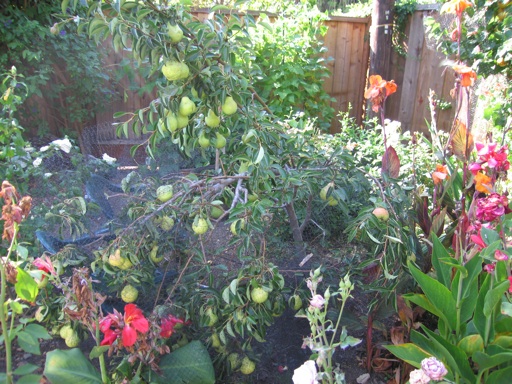
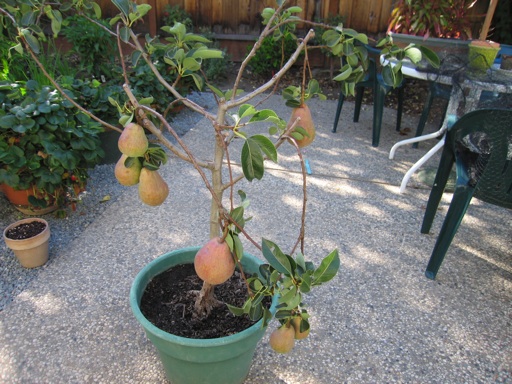
August 15 2008 | Pears | Comments Off on Bartlett Pears

This is a picture of a Santa Rosa Plum tree growing in my parents’ yard. It is full of plums this year, much more than it usually has. Temperate climate fruit trees like plums need a lot of winter chill hours (hours below 45 degrees) to bloom and set fruit. I think part of the reason this tree is producing so heavily is that last winter was colder than normal – at least in terms of night time low temperatures.
In addition, 2008 was a very dry spring in California. It was one of the driest springs on record. Heavy spring rains can reduce fruit production by damaging the blossoms or preventing them from getting pollinated. The dry weather has probably increased fruit tree production this year.
2008 has also been a bountiful year for fruit trees in my yard too. My peach, pear, nectarine, apricot, and apple trees are full of fruit. I don’t have a plum tree right now. In general, plums are not at the top of my list of favorite fruits, but Santa Rosa plums do have a nice sweet-tart flavor. They are mainly fresh eating plums, because the fruit flesh clings tightly to the seed (clingstone), making it hard to cut out for cooking. I would recommend them to anyone considering planting a fruit tree in their yard. One nice thing about plums is that they tend produce fruit at a younger age than other fruit trees, such as pears.
August 10 2008 | Plums | Comments Off on Santa Rosa Plums
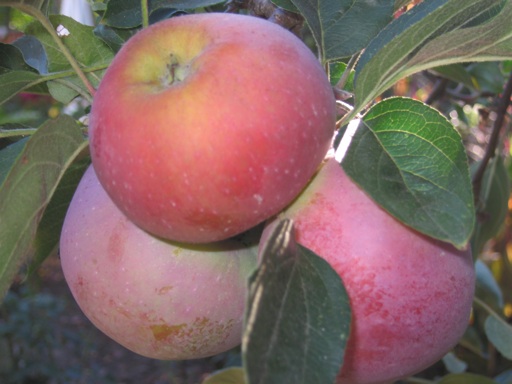
August is Gravenstein apple season in California. Gravenstein apples have been a popular apple here in Northern California for a long time. They are excellent apples for making apple pie and apple sauce, because they have a balanced sweet-tart flavor, and they soften up when cooked.
This is a picture of Gravenstein apples ripening on a small tree in our yard. It’s interesting how red the apples are turning. The apples on my mom’s Gravenstein apple tree are usually yellow with a bit of a red blush. Hers rarely turn this red. There is a variety of apple tree called Red Gravenstein, but our tree was labeled as a regular Gravenstein.
Apple trees are not self-fertile. At least two different varieties of apple trees need to be grown within about 100 feet of each other to achieve successful cross-pollination. Apple trees may not bear apples without proper cross-pollination between two different types of apples. Sometimes an apple tree that is not cross-pollinated produces very small apples or very few apples.
We also have a small Fuji apple tree and a small Granny Smith apple tree. Why three apple trees? Gravenstein apple trees have sterile pollen, which means that a Graventstein will not pollenate the blossoms of another apple tree. Without a third tree, the second tree would not get pollenated. The second apple tree pollenates the Gravenstein and the third apple tree, and the third apple tree pollenates the second apple tree.
Most apples ripen in the late summer or fall. For example, Fuji and Granny Smith apples usually ripen in October into early November. One of the great things about Gravenstein apples is that they ripen early, a month or two before most apples. So we are harvesting apples in the summer and in the fall.
August 03 2008 | Apples | Comments Off on Gravenstein Apple Season

My parents’ vegetable garden (shown above) is looking incredible right now. The Italian green beans my mom planted in April have completely covered the wire fence that my dad put up for them to grow on. The weight of the vines is so heavy that it’s causing the wire fence to sag in the middle.
The vines are just starting to produce a profusion of green beans. They are almost producing more beans than they can eat, even though they haven’t fertilized them. Not only are they fun to harvest, but home-grown green beans are some of the best tasting green beans I have ever eaten.
Green beans are the most tender and delicious if they are picked when the bean pods are small to medium sized. If you pick green beans when the bean seeds inside are large, they are usually tough and less tasty.
My mom starting growing Italian beans several years ago. Last year, she planted bean seeds in my yard. She had gathered the seeds from dried out leftover beans that were still on the vines the previous fall. Those seeds grew and produced an abundance of beans, which we used for great dinner side dishes for months. I saved some of the dried up beans from those plants last fall and planted another generation of beans this spring. They are now full of fruit (see below). I probably won’t need to buy green bean seeds again, at least until I want to try a different variety.
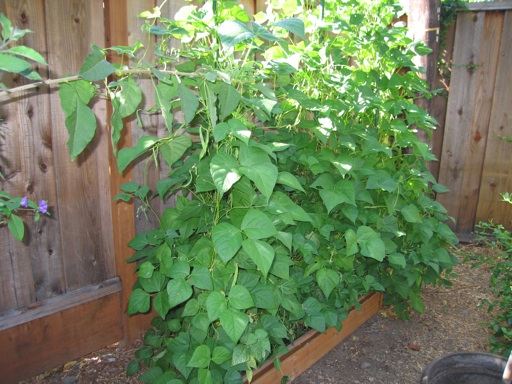
August 02 2008 | Beans | Comments Off on Italian Green Beans
« Prev - Next »








